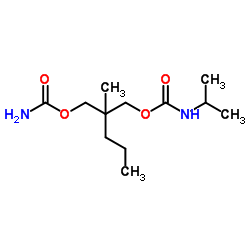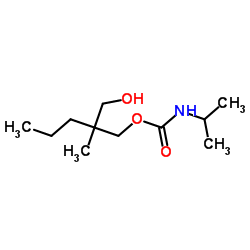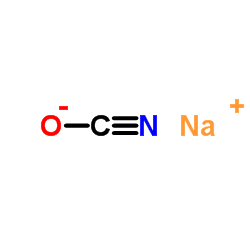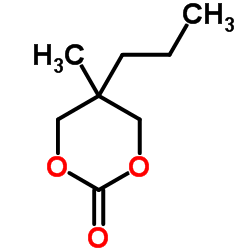78-44-4
| Name | carisoprodol |
|---|---|
| Synonyms |
EINECS 201-118-7
2-[(Carbamoyloxy)methyl]-2-methylpentyl isopropylcarbamate 1-Carbamoyloxy-2-isopropylcarbamoyloxymethyl-2-methyl-pentan Carisol 2-[(carbamoyloxy)methyl]-2-methylpentyl (1-methylethyl)carbamate N-isopropyl 2-methyl-2-propyl-propane-1,3-diol di(carbamate) Carbamic acid, (1-methylethyl)-, 2-(((aminocarbonyl)oxy)methyl)-2-methylpentyl ester RELA 4-methyl-4-propyl-2,6-dioxa-heptanedioic acid amide-isopropylamide Brianil 4-Methyl-4-propyl-2,6-dioxa-heptandisaeure-amid-isopropylamid Flexal carisoprodol cb8019 1-Carbamoyloxy-3-isopropylcarbamoyloxy-2-methyl-2-propyl-propan Carisoma 2-[(carbamoyloxy)methyl]-2-methylpentyl (1-methylethyl)carbamate (non-preferred name) 2-{[(aminocarbonyl)oxy]methyl}-2-methylpentyl isopropylcarbamate Mioril carbamic acid, (1-methylethyl)-, 2-[[(aminocarbonyl)oxy]methyl]-2-methylpentyl ester Carbamic acid, N-(1-methylethyl)-, 2-[[(aminocarbonyl)oxy]methyl]-2-methylpentyl ester Apesan Sanoma Arusal 2-[(carbamoyloxy)methyl]-2-methylpentyl propan-2-ylcarbamate (non-preferred name) Soma MFCD00057661 Calenfa |
| Density | 1.1±0.1 g/cm3 |
|---|---|
| Boiling Point | 423.4±28.0 °C at 760 mmHg |
| Melting Point | 92-92°C |
| Molecular Formula | C12H24N2O4 |
| Molecular Weight | 260.330 |
| Flash Point | 209.9±24.0 °C |
| Exact Mass | 260.173615 |
| PSA | 90.65000 |
| LogP | 2.15 |
| Vapour Pressure | 0.0±1.0 mmHg at 25°C |
| Index of Refraction | 1.466 |
| Storage condition | 2-8°C |
| Water Solubility | <0.1 g/100 mL at 19.5 ºC |
|
Section 1. Chemical Product and Company Identification CarisoprodolCatalog Common Name/ Number(s). Trade Name CAS#78-44-4 Manufacturer
RTECSFB3325000 SPECTRUM QUALITY PRODUCTS INC. TSCATSCA 8(b) inventory: No products were found. Commercial Name(s)Not available. CI# Not available. Synonym2-Methyl-2-Propyl-1,3-Propanediol Carbamate Isopropylcarbamate IN CASE OF EMERGENCY Carisoprodol Chemical Name Chemical FamilyNot available.CALL (310) 516-8000 C12-H24-N2-O4 Chemical Formula SPECTRUM QUALITY PRODUCTS INC. Section 2.Composition and Information on Ingredients Exposure Limits TWA (mg/m3)STEL (mg/m3) CEIL (mg/m3) NameCAS #% by Weight 1) Carisoprodol78-44-4100 Toxicological DataCarisoprodol: on IngredientsORAL (LD50):Acute: 1320 mg/kg [Rat]. 1800 mg/kg [Mouse]. Section 3. Hazards Identification Potential Acute Health Effects Hazardous in case of ingestion, of inhalation. Potential Chronic HealthCARCINOGENIC EFFECTS: Not available. MUTAGENIC EFFECTS: Not available. Effects TERATOGENIC EFFECTS: Not available. DEVELOPMENTAL TOXICITY: Classified Development toxin [POSSIBLE]. The substance may be toxic to lungs, liver, upper respiratory tract, central nervous system (CNS), throat. Repeated or prolonged exposure to the substance can produce target organs damage. Carisoprodol Section 4. First Aid Measures Eye ContactCheck for and remove any contact lenses. In case of contact, immediately flush eyes with plenty of water for at least 15 minutes. Get medical attention. Skin ContactIn case of contact, immediately flush skin with plenty of water. Remove contaminated clothing and shoes. Wash clothing before reuse. Thoroughly clean shoes before reuse. Get medical attention. Serious Skin ContactNot available. InhalationIf inhaled, remove to fresh air. If not breathing, give artificial respiration. If breathing is difficult, give oxygen. Get medical attention. Serious InhalationNot available. IngestionDo NOT induce vomiting unless directed to do so by medical personnel. Never give anything by mouth to an unconscious person. If large quantities of this material are swallowed, call a physician immediately. Loosen tight clothing such as a collar, tie, belt or waistband. Serious IngestionNot available. Section 5. Fire and Explosion Data Flammability of the Product May be combustible at high temperature. Auto-Ignition Temperature Not available. Flash PointsNot available. Flammable LimitsNot available. These products are carbon oxides (CO, CO2), nitrogen oxides (NO, NO2...). Products of Combustion Fire Hazards in Presence of Not available. Various Substances Explosion Hazards in Presence Risks of explosion of the product in presence of mechanical impact: Not available. of Various SubstancesRisks of explosion of the product in presence of static discharge: Not available. Fire Fighting MediaSMALL FIRE: Use DRY chemical powder. and InstructionsLARGE FIRE: Use water spray, fog or foam. Do not use water jet. Special Remarks onNot available. Fire Hazards Special Remarks on Explosion Not available. Hazards Section 6. Accidental Release Measures Small SpillUse appropriate tools to put the spilled solid in a convenient waste disposal container. Finish cleaning by spreading water on the contaminated surface and dispose of according to local and regional authority requirements. Large Spill Use a shovel to put the material into a convenient waste disposal container. Finish cleaning by spreading water on the contaminated surface and allow to evacuate through the sanitary system. Carisoprodol Section 7. Handling and Storage PrecautionsKeep locked up.. Keep away from heat. Keep away from sources of ignition. Empty containers pose a fire risk, evaporate the residue under a fume hood. Ground all equipment containing material. Do not ingest. Do not breathe dust. Wear suitable protective clothing. In case of insufficient ventilation, wear suitable respiratory equipment. If ingested, seek medical advice immediately and show the container or the label. StorageKeep container tightly closed. Keep container in a cool, well-ventilated area. Section 8. Exposure Controls/Personal Protection Engineering ControlsUse process enclosures, local exhaust ventilation, or other engineering controls to keep airborne levels below recommended exposure limits. If user operations generate dust, fume or mist, use ventilation to keep exposure to airborne contaminants below the exposure limit. Personal ProtectionSafety glasses. Lab coat. Personal Protection in Case of Splash goggles. Full suit. Boots. Gloves. Suggested protective clothing might not be sufficient; consult a a Large Spillspecialist BEFORE handling this product. Exposure LimitsNot available. Section 9. Physical and Chemical Properties Physical state and appearance Solid. (Crystalline solid.)OdorNot available. Bitter. (Slight.) Taste Molecular Weight260.33 g/mole Not available. Color Not applicable. pH (1% soln/water) Boiling PointNot available. 92.5°C (198.5°F) Melting Point Critical TemperatureNot available. Specific GravityNot available. Not applicable. Vapor Pressure Vapor DensityNot available. Not available. Volatility Odor ThresholdNot available. Water/Oil Dist. Coeff.Not available. Ionicity (in Water)Not available. Dispersion PropertiesVery slightly dispersed in methanol, diethyl ether, n-octanol, acetone. Is not dispersed in cold water, hot water. SolubilityVery slightly soluble in methanol, diethyl ether, n-octanol, acetone. Insoluble in cold water, hot water. Section 10. Stability and Reactivity Data StabilityThe product is stable. Instability TemperatureNot available. Conditions of InstabilityNot available. Incompatibility with various Not available. substances Carisoprodol CorrosivityNot available. Special Remarks onNot available. Reactivity Special Remarks onNot available. Corrosivity PolymerizationWill not occur. Section 11. Toxicological Information Routes of EntryInhalation. Ingestion. Toxicity to AnimalsAcute oral toxicity (LD50): 1320 mg/kg [Rat]. Chronic Effects on HumansCARCINOGENIC EFFECTS: (Inadequate study.) by NTP. DEVELOPMENTAL TOXICITY: Classified Development toxin [POSSIBLE]. May cause damage to the following organs: lungs, liver, upper respiratory tract, central nervous system (CNS), throat. Other Toxic Effects onHazardous in case of ingestion, of inhalation. Humans Special Remarks onNot available. Toxicity to Animals Special Remarks onNot available. Chronic Effects on Humans Special Remarks on otherNot available. Toxic Effects on Humans Section 12. Ecological Information EcotoxicityNot available. BOD5 and CODNot available. Products of BiodegradationPossibly hazardous short term degradation products are not likely. However, long term degradation products may arise. Toxicity of the ProductsThe products of degradation are less toxic than the product itself. of Biodegradation Special Remarks on theNot available. Products of Biodegradation Section 13. Disposal Considerations Waste Disposal Section 14. Transport Information DOT ClassificationNot a DOT controlled material (United States). IdentificationNot applicable. Not applicable. Special Provisions for Transport Carisoprodol DOT (Pictograms) Section 15. Other Regulatory Information and Pictograms California prop. 65: This product contains the following ingredients for which the State of California has found to Federal and State cause cancer, birth defects or other reproductive harm, which would require a warning under the statute: Regulations Carisoprodol California prop. 65: This product contains the following ingredients for which the State of California has found to cause reproductive harm (female) which would require a warning under the statute: Carisoprodol California prop. 65: This product contains the following ingredients for which the State of California has found to cause cancer which would require a warning under the statute: Carisoprodol TSCA 8(d) H and S data reporting: Carisoprodol: June 1999 CaliforniaCalifornia prop. 65: This product contains the following ingredients for which the State of California has found to cause cancer which would require a warning under the statute: Carisoprodol Proposition 65 Warnings Other RegulationsEINECS: This product is on the European Inventory of Existing Commercial Chemical Substances. WHMIS (Canada) Not controlled under WHMIS (Canada). Other Classifications DSCL (EEC)R22- Harmful if swallowed. R40- Possible risks of irreversible effects. R63- Possible risk of harm to the unborn child. Health Hazard HMIS (U.S.A.)2 National Fire Protection 1 Flammability 1 Association (U.S.A.) Fire Hazard 2 0 Reactivity Health Reactivity 0 Specific hazard Personal Protection a WHMIS (Canada) (Pictograms) DSCL (Europe) (Pictograms) TDG (Canada) (Pictograms) ADR (Europe) (Pictograms) Protective Equipment Not applicable. Carisoprodol Lab coat. Not applicable. SECTION 16 - ADDITIONAL INFORMATION N/A |
CHEMICAL IDENTIFICATION
HEALTH HAZARD DATAACUTE TOXICITY DATA
|
| Symbol |

GHS07 |
|---|---|
| Signal Word | Warning |
| Hazard Statements | H302 |
| Precautionary Statements | P301 + P312 + P330 |
| Hazard Codes | Xn: Harmful; |
| Risk Phrases | R22 |
| Safety Phrases | S36 |
| RIDADR | NONH for all modes of transport |
| RTECS | FB3325000 |
| HS Code | 2924199090 |
|
~79% 
78-44-4 |
| Literature: Gorodetskii, L. Sh.; Volzhina, O. N.; Kuznetsova, I. A.; Alekseeva, E. N. Pharmaceutical Chemistry Journal, 1982 , vol. 16, # 6 p. 474 - 477 Khimiko-Farmatsevticheskii Zhurnal, 1982 , vol. 16, # 6 p. 718 - 721 |
|
~% 
78-44-4 |
| Literature: Pharmaceutical Chemistry Journal, , vol. 16, # 6 p. 474 - 477 Khimiko-Farmatsevticheskii Zhurnal, , vol. 16, # 6 p. 718 - 721 |
|
~% 
78-44-4 |
| Literature: Pharmaceutical Chemistry Journal, , vol. 16, # 6 p. 474 - 477 Khimiko-Farmatsevticheskii Zhurnal, , vol. 16, # 6 p. 718 - 721 |
|
~% 
78-44-4 |
| Literature: Monatshefte fuer Chemie, , vol. 94, p. 426 - 433 |
| Precursor 5 | |
|---|---|
| DownStream 0 | |
| HS Code | 2924199090 |
|---|---|
| Summary | 2924199090. other acyclic amides (including acyclic carbamates) and their derivatives; salts thereof. VAT:17.0%. Tax rebate rate:13.0%. . MFN tariff:6.5%. General tariff:30.0% |




